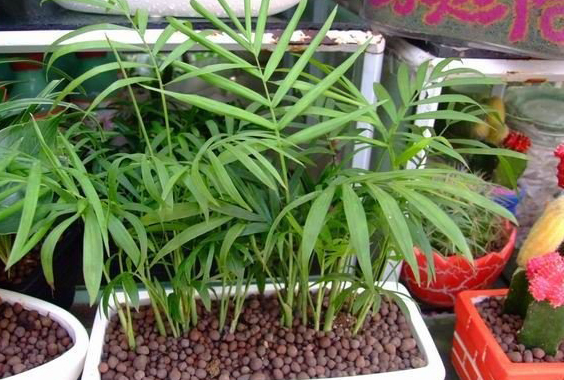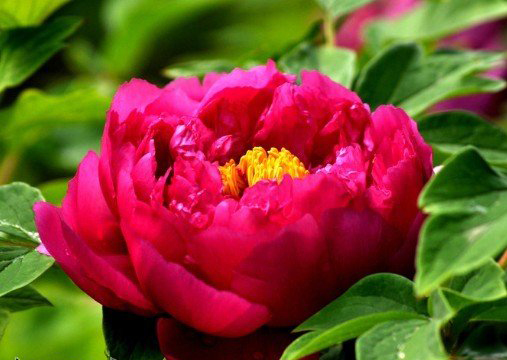The cause of yellow coconut leaves
The cause of the yellowing of pocket coconut leaves may be caused by the following species or a variety of common causes, because in different environments, plant conditions are different, and specific problems need to be solved by flower friends themselves. I hope the following incomplete summary can help flower friends who encounter this problem.
L, the root injury caused by changing the basin, pruning, putting it in semi-shade ventilation is better to slow the seedling, do not water before returning to normal.
2, caused by stagnant water, based on the principle of dry rather than wet, the basin soil can always be kept moist. Watering can be done after the topsoil is dry.
3. Humidity problem, which requires high air humidity, dry weather slightly increases air humidity, and summer maintenance temperature needs more. When there is dust on the leaves of the plant, rinse it with clean water as far as possible.
4. in the case of sunlight exposure, I like the scattered light with bright light, and the leaves will turn yellow when the strong light is directed.
5. due to the lack of fertilizer, the leaves of flowers are thin and yellow. this is because the big pots of flowers are small or have not changed pots for a long time, soil change and lack of fertilizer, so water and fertilizer should be increased gradually and pots should be changed at the right time.
6. Diseases and insect pests can also cause yellowing of leaves. Red spiders should be prevented in the process of maintenance.
7. Other reasons.

Culture method of pocket coconut
Pocket coconut, also known as dwarf coconut. The plant is shaped like a tropical coconut tree, green all the year round, petite and lovely. Indoor display-basin, can reproduce the tropical scenery, full of charm. Because the root system of pocket coconut is slender, it is appropriate to choose loose and fertile culture soil when potted, and the use of clayey soil is easy to cause rotten roots. Because it likes a more shady environment, indoor training should be placed near the north window, east window or other places with bright scattered light. Causes of yellowing of pocket coconut leaves and its solutions
Pocket coconut is a common potted plant in home, which has a good effect on beautifying the environment, but sometimes the leaves turn yellow. let's take a look at the causes and solutions of the yellowing of pocket coconut leaves:
Causes of yellowing of pocket coconut leaves:
Reasons for the yellowing of pocket coconut leaves: 1. The light is too intense.
Pocket coconut likes semi-overcast conditions. when the light is too strong, the pocket coconut leaves will turn pale or yellow, losing their ornamental value. Solution: keeping the pocket coconut in a place with plenty of astigmatism can not only provide enough light to grow, but also will not cause the leaf yellowing problem caused by excessive light.
Reasons for the yellowing of pocket coconut leaves: 2. Too little watering
Pocket coconuts like to be wet and need plenty of water. If they are watered too little, the leaves will turn yellow and gradually wither and fall. Solution: often watering to keep the basin soil moist, when the air is dry in summer and autumn, often spray water to the plant to improve the air humidity of the environment.
The reason for the yellowing of pocket coconut leaves: 3. Excessive fertilization
Pocket coconuts do not have high requirements for fertilizer, if you apply too much fertilizer, fertilizer damage will occur, resulting in pocket coconut leaves yellowing. Solution: apply liquid fertilizer 1-2 times a month in the growing season of pocket coconut, with little or no fertilization in late autumn and winter.
Causes of yellowing of pocket coconut leaves: 4. Disease infection
Pocket coconut is easy to be infected by root rot in high temperature season, and the disease infection will cause pocket coconut leaves to turn yellow and wilt, and in serious cases, it will cause plant death. Solution: pay attention to pocket coconut growth environment ventilation and soil ventilation, when the disease can be sprayed with topiramate and chlorothalonil.
The yellowing of pocket coconut leaves is caused by improper maintenance of pocket coconut, which needs to find out the reasons and take corresponding solutions, so as to make the growth of pocket coconut green and beautiful, and continue to beautify our home environment.
What is the solution to the yellowing of pocket coconut leaves?
Pocket coconuts are easy to raise and pleasing, so they are very popular. However, in the process of maintenance, it is also very easy to yellowing leaves. So what is the reason for the yellowing of pocket coconut leaves? What is the solution?
Chronic water shortage will lead to yellowing of pocket coconuts.
The growth rate of pocket coconut is very fast, so its growth process needs sufficient water to supply, otherwise the lack of water, the basin soil is too dry will lead to the phenomenon of yellow leaves.
Solution.
The growth of pocket coconut needs to be accompanied by regular watering to keep the basin soil moist, so as to ensure the healthy growth and development of the plant.
Excessive light leads to yellowing of pocket coconuts
Pocket coconuts like semi-humid and semi-overcast environment, so places with excessive light are not suitable for the growth of pocket coconuts. Strong sunlight will make pocket coconuts fade or turn yellow, losing their original bright and ornamental value.
Solution.
Pocket coconuts should be preserved in places where there is plenty of scattered light on a daily basis, which will not only benefit plant growth but also reduce health problems caused by yellowing leaves.
Air dryness causes pocket coconuts to turn yellow
Humidity is also an important element in the growth of pocket coconuts, and low humidity can cause leaves to wither.
Solution.
In order to maintain the appropriate air humidity, the air humidity must be high, and water can be sprinkled around the pot to prevent the humidity from decreasing and ensure the normal growth and development of the plant.
Lack of light causes pocket coconuts to turn yellow
Pocket coconuts tend to grow in a cold environment, so putting them in places with more intense sunlight will turn the leaves yellow and lead to death.
Solution.
Daily maintenance needs to place pocket coconuts in places where the growth light is not strong, which will meet the growth needs of pocket coconuts.
Improper fertilization leads to yellowing of pocket coconuts
The growth and development of pocket coconuts need to meet all the nutrients they need, so they need to be fertilized in time, but not too frequently.
Solution.
The time of fertilization can be relatively extended, and the degree of fertilization should be appropriate.
Diseases and insect pests lead to yellowing of pocket coconut leaves
High temperatures in summer can cause pocket coconuts to be infected with diseases and insect pests, resulting in yellowing of leaves and, in severe cases, withering and death of plants.
Solution.
During the growth of pocket coconuts, attention should be paid to maintaining the ventilation of the environment and the permeability of the soil. If diseases are found and outbreaks, chlorothalonil and topiramate can be sprayed for control.
- Prev

The main reason why peony leaves are easy to burn
Summer temperature is on the high side, peony leaves by strong light irradiation, sometimes there will be leaf tip, leaf edge yellow dry phenomenon. According to the observation and analysis of many years, the author talks about its causes and preventive measures. The reason for the dry tip and dry edge of peony leaves 1. The alkaline soil of the soil reduces the absorption of water and nutrients by peony roots
- Next

The leaves of sweet-scented osmanthus dried up
Sweet-scented osmanthus, also known as sweet clover and rock cinnamon, is an evergreen shrub or small Qiao of the sweet-scented osmanthus family, but it does not seem to be easy to raise. Summing up the situation of flower friends, it is found that in the process of culture, many people will encounter the problem that the leaves of sweet-scented osmanthus dry or even turn brown or black.
Related
- Fuxing push coffee new agricultural production and marketing class: lack of small-scale processing plants
- Jujube rice field leisure farm deep ploughing Yilan for five years to create a space for organic food and play
- Nongyu Farm-A trial of organic papaya for brave women with advanced technology
- Four points for attention in the prevention and control of diseases and insect pests of edible fungi
- How to add nutrient solution to Edible Fungi
- Is there any good way to control edible fungus mites?
- Open Inoculation Technology of Edible Fungi
- Is there any clever way to use fertilizer for edible fungus in winter?
- What agents are used to kill the pathogens of edible fungi in the mushroom shed?
- Rapid drying of Edible Fungi

